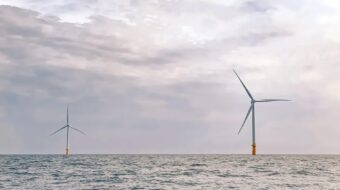
Is this for real? The right-wing American Enterprise Institute and two centrist-liberal groups, the Brookings Institution and Breakthrough Institute, have announced a proposal to boost government spending on clean energy research and development by as much as $20 billion a year.
The plan, released Oct. 13, is titled “Post-Partisan Power.” It is presented as an alternative to efforts to directly curb carbon dioxide and other global warming gas emissions.
The proposal is drawing praise from some as a way to deal with “political reality.” But others are sharply critical.
The Obama administration’s energy bill, including modest steps to curb emissions, was blocked this summer by a solid wall of Republicans, with help from some Democrats, many with ties to the oil, gas and coal industries.
The bill, criticized by some environmentalists for being too weak, included caps on industrial greenhouse gas emissions, allowing companies to buy and sell emissions “credits” – the so-called “cap-and-trade” system. It also included some funding for clean energy research and development. It was filled with concessions to the energy industry. Cap-and-trade itself is a “business friendly strategy” embraced by centrists “precisely because conservatives had demonized regulations and mandates,” notes liberal Climate Progress blogger Joe Romm.
But any idea of curbing emissions was a no-go for the oil, gas and coal companies and those in Congress who are beholden to them.
The “Post-Partisan Power” plan includes no curbs on carbon emissions. It does suggest “modestly increasing” the royalties paid by oil and gas companies, a “small fee” on imported oil, and a “very small carbon price.”
The plan makes a case for major federal government investment, calling it a “critical component” that will “yield long-term economic returns.”
It also says such spending must not add to the federal deficit, and the way to handle that includes “responsible entitlement reform” (read: Social Security and/or Medicare cuts) and “targeted spending cuts” (read: cuts in social programs, NOT military spending).
Romm calls the plan a “head-fake” by the right-wing AEI.
First of all, he says, it’s a “dead end” because “you can be 100% certain that the a top priority of the tea-party-led Republicans, especially if they take the House or Senate, will be to cut funding for clean energy.”
Second, says Romm, “the omission of any federal standards for either energy efficiency or renewable energy is quite glaring.”
At the environmental journal Grist, David Roberts rejects the plan’s pitting of research and innovation against curbs and regulations. Legislation to require emissions cuts, regulation forcing industry to absorb some of the costs of protecting the environnment and public health, and major government investment in research and development are all necessary, he says.
“Clean energy advocates are in a war against a politically entrenched, well-financed, and fairly monolithic status quo,” Grist writes. “Those that benefit from the status quo don’t want their prerogatives and privileges put in danger. Any policy that threatens to do so will be met with the same furious demagoguery that met cap-and-trade. That’s precisely why the war needs to be fought on multiple fronts, in particular: legislation, regulation, and investment.”
Cap-and-trade was “a threat to the status quo, so the status quo marshaled billions of dollars, astroturf groups, and friendly politicians to demonize it. Massive clean energy R&D would also threaten the status quo, and so if it moved from a think tank fantasy to a live option, the status quo would demonize it too. (Remember, cap-and-trade itself started as the Very Reasonable centrist alternative to hippie regulations.)”
The “Post-Partisan” proposal continues a battle that goes back to 2003 over how to advance a green energy shift in the U.S. At that time, Breakthrough Institute co-founders Michael Shellenberger and Ted Nordhaus provoked controversy in liberal and environmentalist circles by arguing that no strategy that “significantly raises energy prices” could succeed politically and that any successful effort to deal with climate change must focus instead on making large public investments to “make clean energy cheap.”
But the question is, raise prices for whom – who should pay?
And why would the American Enterprise Institute – opposed to “big government,” a booster of “free enterprise” – support a plan for massive government spending?
Note that Exxon Mobil has been among AEI’s top funders for at least a decade, along with a host of far-right foundations.
So one has to wonder, is this plan a step forward, or a way to try to deter curbs on the oil, gas and coal industries? And, even though AEI and its right-wing associates hate big government, perhaps some among them see the necessity to jump on the green energy wave, so why not get the government to pay for the research and development, while the “free market” energy industry reaps the profits? And meanwhile, no restrictions on their free market right to spew carbon, please!
Meanwhile, reports the Center for American Progress, “Big Oil and its special interest allies have spent more than $68.5 million combined since the beginning of 2010 on misleading and fictitious televisions ads designed to shape midterm elections and advance their anti-clean energy reform agenda.” See how your state is affected in the center’s clever interactive chart.
Photo: ktylerconk cc 2.0

MOST POPULAR TODAY

High Court essentially bans demonstrations, freedom of assembly in Deep South

Zionist organizations leading campaign to stop ceasefire resolutions in D.C. area


UN warns that Israel is still blocking humanitarian aid to Gaza

U.S. imperialism’s ‘ironclad’ support for Israel increases fascist danger at home






Comments